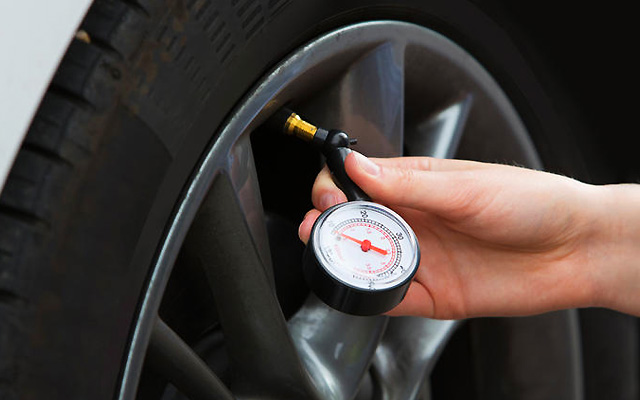Tyre pressure is important for your safety, how your car drives and its fuel economy. Make sure you check yours regularly to keep your car running smoothly.
Here’s how to check your tyre pressure.

How do I check tyre pressure?
The best way to check your tyre pressure is by using a good-quality, accurate tyre pressure gauge. Here’s how to do it step-by-step:
1. Check your recommended PSI
- Check the manufacturer’s recommended PSI before you start so you’ll know if any tyres are under (or over) inflated.
2. Remove the valve cap and insert the pressure gauge
- Remove the valve cap from one tyre.
- Press the pressure gauge onto the valve stem until the hissing sound stops and the gauge gives a reading.
- Write down the reading for the tyre.
- Repeat for the other tyres.
3. Let air out if necessary
- If tyres are over-inflated, you can let air out of them.
- Inside the valve stem is a metal pin - press this with a screwdriver to let air out.
4. Refill with air if necessary
- If any tyres are under-inflated, use an air-compressor to refill them.
- Press the air compressor hose onto the valve stem and fill until the right PSI (as per your car’s manufacturer) is shown on the gauge.
What is the correct tyre pressure for my car?
Your vehicle handbook will tell you what pressure you should have in your tyres.
Often you’ll find a small sticker with the tyre pressures on too – usually inside the fuel filler flap or on the drivers’ door edge.
It'll give you a figure in pounds per square inch (PSI) or BAR pressure. BAR is the metric unit of atmospheric pressure equal to 14.50 pounds per square inch.
- Pressures are given for cold tyres (ones that haven’t been driven for at least 2 hours).
- There are usually two figures, one for 'normal' use and a higher figure for full loads.
If you can't find the correct tyre pressures, contact the vehicle manufacturer’s customer services team. You’ll need a note of:
- The size of the tyres fitted, taken from the sidewalls.
- The make, model and registration number of your vehicle.
Read what to do if your tyre's gone flat:
When should I check tyre pressure?
You should only check your tyre pressure when the tyres are cold. ‘Cold’ means that the car hasn’t been driven for a couple of hours.
The pressure inside your tyres increases as they heat up. If you set your pressures when your tyres are already warm, their pressure will probably be too low.
If you’re driving to a garage or petrol station to check your tyres, try to go at the start of your journey to one that’s only a short drive away. That way, your tyres won’t heat up too much. If you go in the middle of a long journey, your tyres will be warm which will affect the pressure reading.
How often should I check tyre pressure?
Aim to check your tyre pressures every couple of weeks.
Makes sure the tyres are cold and use a reliable tyre pressure gauge.
Where can I check my tyre pressure for free?
Some of the big chains of garages and tyre shops offer a free tyre-checking service where they’ll also check your tyre pressures.
Otherwise, many petrol stations have a coin-operated tyre pressure pump near the forecourt. You can check your pressure and top up with air for the price of a few coins in loose change.
What happens if I drive with the wrong tyre pressure?
It could be dangerous to drive with the wrong tyre pressure as it can affect stopping distances and make a blow-out more likely.
Plus, under or over inflation increases tyre wear so you’ll have to buy new tyres more often.
Dangers of under-inflated tyres
- Tyres will flex more and get hotter, making sudden tyre failure (blowouts) more likely.
- Under inflated tyres will increase stopping distances and affect your vehicle’s handling, making collisions more likely.
- Tyre will wear more on the edges of the tread.
- Increases your tyre’s rolling resistance which means higher fuel consumption.
Low or uneven tyre pressure can also cause steering problems.
Dangers or over-inflated tyres
- Tyres will wear more in the centre of the tread.
- Less contact area with the road which can cause a loss of traction.
- Increased stopping distances.
Higher pressures can mean a harsher more uncomfortable ride, but don’t be tempted to reduce pressures for a softer ride.
Other ways to care for your tyres
Taking care of your tyres is one way to make sure you’re driving safely and efficiently and avoid a breakdown.
- Take a bit of time to check the tread for wear and also to look for cuts, or bulges on the sidewalls.
- Get any cut you find checked out by a tyre specialist.
- A bulge means the tyre’s got internal damage and must be replaced.
Some elements of your tyres will be checked as part of the MOT test, so it’s especially important to check the tread and get any cuts looked at before you book an MOT.
Find out more about tyre care.
Published:6 February 2017 | Updated: 5 October 2020 | Author: The AA
